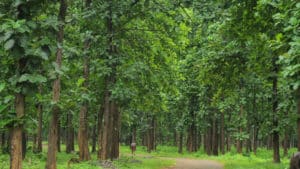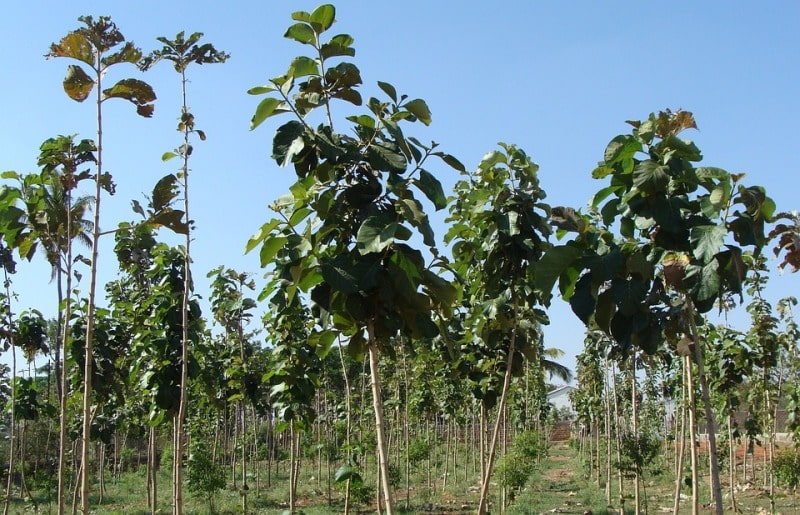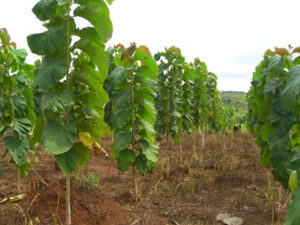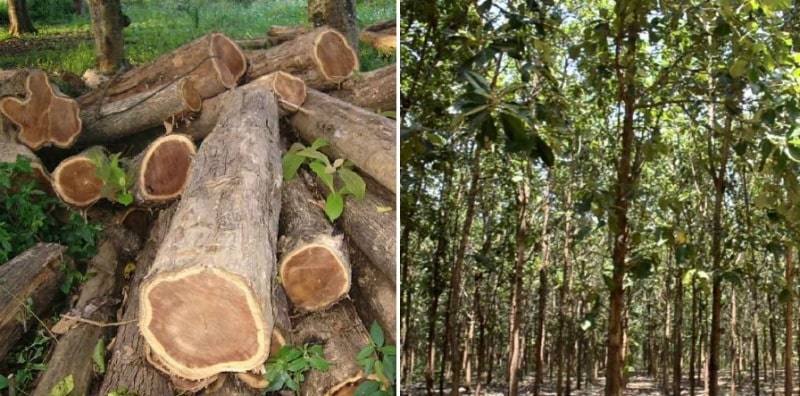Teak Wood Farming – A Step by Step Guide
If you are planning for commercial teak plantation, you must be aware of seed rate of teakwood, the yield of teakwood, planting methods, care along with teak harvesting techniques. So why wait, let us dive into detailed farming of teak wood.
Teak wood known as the king of timber belongs to the family Verbenaceae. Its scientific name is Tectona grandis. It grows as a huge tree and yields excellent quality wood. Therefore teak wood has a higher demand in national as well as International markets. Articles made of teak wood have high durability/quality and hence with the increased consumption of teak in household and office interiors, teak has become an indispensable part of people’s lives all over the world. Normally superior teak plants are grown on a commercial scale, it is possible to earn good profits with low risk. When grown on fertile soils with irrigation and scientific management, each tree yields 10 to 15 Cu. ft wood in about 14 years. The main stem grows to a height of 25-30 ft. and attains a girth of 35-45 inches. About 400 genetically superior teak plants can be grown in one acre, by adopting a spacing of teak plants as 9 ft. by 12 ft.

Varieties of Teak wood:
Below are some of the typical varieties of Teak wood cultivation in India.
1) Nilambur (Malabar) teak 2) South and Central American teak 3) West African teak 4) Adilabad teak 5)Godhavari teak 6)Konni teak.
The climatic requirement for Teak wood production:
Teak prefers moist, warm tropical climate. It can withstand extremes of temperature, but maximum & minimum shade temperatures of 39- 44 0 c and 13 – 17 0 c respectively are the most favorable for its growth. It grows well in rainfall zone of 1200-2500 mm. Teak has been classified as a pioneer species. Hence, it requires a high light intensity for its growth and development.

Apart from rainfall and moisture, soil and light intensity, other factors such as temperature and elevation also play important roles in limiting the distribution and growth pattern of the species.
You may be interested to read Brinjal Farming Profit, Cost, Yield.
Soil requirement for Teak wood plantation:
Teak grows best on deep, well-drained alluvial soils derived from limestone, schist, gneiss, shale (and some volcanic rocks, such as basalt. Conversely, the species performs very poorly, in terms of growth and stem forming, on dry sandy soil, shallow soil (hardpan soil or lower water table soil), acidic soil (pH < 6.0) derived from laterite or peat bog, and on compacted or waterlogged soil.
Soil pH is another factor limiting the distribution and stand development of the species. Although the range of soil pH in teak forests is wide (5.0-8.0), the optimum pH range for better growth and quality is between 6.5-7.5.
Calcium Importance in Teak wood Plants:
Teak soil is relatively fertile with high calcium (Ca), phosphorus (P), potassium (K), nitrogen (N) and organic matter (OM) contents. Several research studies indicate that teak requires relatively large amounts of calcium for its growth and development, and teak has been named as a calcareous species. The amount of calcium content in the soil is also used as an indicator of teak site quality. That is, the greater the proportion of teak to other associated species, the higher the calcium content in the forest soil.
Nursery raising of Teak wood plantation and seed rate:
Well-drained sandy loam with gently sloping terrain is suitable for preparing nurseries. Each bed is of 1.2 m (12 m size, spaced at 0.3 m to 0.6 m between beds and 0.6 m to 1.6 m between rows of beds. Each bed produces about 400-800 plantable stumps. The ground is plowed and the area of the bed is dug out to a depth of 0.3 m. Roots, stumps, and stones are removed. The clods of earth are broken fine. The soil is allowed to weather for about a month and then filled into the nursery bed with sand and organic matter. However, when temporary nurseries are established in forest areas rich in nutrients, no additional manurial inputs are necessary.
In the moist localities, the beds are raised to a height of 30 cm from ground level to prevent waterlogging. In dry zones, beds are made flush with the ground level. In very dry localities, with a mean annual rainfall of 750 mm or less, slightly sunken beds give better results.
The seed rate per standard bed of 12 m (1.2 m varies from 3 kg to 12 kg. At Nilambur in Kerala, about 5kg of seeds are commonly used.
You may be interested in reading Symptoms, Signs of Goat Pregnancy.
Teak wood sowing method:
Both broadcast sowing and line sowing or dibbling 5-10 cm apart are practiced. Line sowing or dibbling method have greater seed economy and better survival and growth. Beds normally do not need any overhead shade. Irrigation is not provided except in very dry areas. Beds are maintained free of weeds.
The spacing of Teak wood Plants:
Teak can be planted at 2m x 2m, 2.5m x 2.5m or 3m x 3m. It can also be raised along with agricultural crops at a spacing of 4m x 4m or 5m x 1m.

Land preparation and planting and care of Teak wood
The site for planting may be either plain or gently sloping with excellent drainage. Soils derived from gneisses, schists and trap are good for teak. Alluvial sites are superior for teak growth while laterite or lateritic gravel as well as clays, black cotton, sandy and gravelly soils derived from sandstone are not good for teak plantations. Ploughlands thoroughly and level it off. Mark the areas for pit digging by alignment and staking.
- Use pre-sprouted stumps or poly pots for planting.
- Dig pits of 45 cm x 45 cm x 45 cm sizes. Refill the soil after seasoning and mixing with Farm Yard Manure(FMY) and insecticides. On poor gravely sites, replace the pit soil by good soil with good organic matter.
- Apply 100 g of fertilizer in the pit at the time of planting and thereafter in split doses or as per the fertility status of the soil.
- Best planting season for Teak wood farming is monsoon; preferably after the first shower.
- Carry out soil working periodically for better growth of plants. One working in the Ist year and two workings in 2nd and 3rd year may be adequate.
- Firm up the soil after planting and apply irrigation/water supply wherever necessary.
- Debudding in the initial years may be done to improve the quality of timber.
Weed control in Teak wood Plantation:
Teak is a light-demanding species and its growth and development are reduced sharply under poor light conditions. Hence, intensive weeding is very necessary during the early establishment of the plantation, i.e. 1-3 years. Carry out weeding operations on a regular basis. Weeding may be carried out at 3 operations in the first year, 2 operations in the second year and one operation in the third year.
Irrigation requirement for Teak wood plantation:
Irrigation during the stress period boosts the growth of the plants. In the farming of teak wood, irrigation should be followed by weeding (3,2,1) and adequate soil working. Two doses of fertilizer (in the month of August & September) @ 50 gm per plant of NPK (15:15:15) may be provided every year up to three years. By increasing the inputs of irrigation and frequent thinning, it is possible to increase the rate of diameter growth. The increase in diameter growth is, however, dependent on increasing the size of the crown i.e. the decrease in the number of trees per acre. In other words, one can have either lesser no. of trees of higher girth or larger number of trees of lower girth. It has been observed that teak trees grown under irrigated condition grew faster but the sapwood content of trees increased, the wood became weak and wind damage became quite serious. A phenomenon of water blisters may also develop in teak trees grown under irrigated conditions. Such trees may appear quite healthy from outside but the inner heartwood may develop rot due to the storage of excess water that increases the spread of fungi which may further damage the tree.
You may be interested in reading the Teak Wood Farming Project Report.
The Teak plants grow best when the minimum monthly temperature is above 13°C and the maximum monthly temperature is below 40°C. Optimal rainfall for teak ranges between 1 250 and 3 750 mm per year; however, for the production of good-quality timber the species requires a dry season of at least four months with less than 60 mm precipitation. The spacing of trees and the number, timing and intensity of thinnings strongly affect the pattern of growth and the yield of the plantation. If thinning is practiced late, growth rates decline or cease, whereas if the stand is thinned too early or too heavily
Thinning of Teak wood plants:
The first thinning is conducted in Teak plantation at 5-10 years after planting of teak, depending on site quality and the size of initial spacing. Generally, under good site and close spacing (1.8×1.8 m and 2×2 m), the first and second thinning (mechanical thinnings) are conducted at 5 and 10 years respectively. About 25% of the trees are left for further growth and development after the second thinning.
Intercropping in Teak wood Plantation:
Intercropping in teak plantations during the initial two years of planting is a common practice where there is a demand for cultivatable land. Once the plantation area is leased out, the cleaning of the site, burning, staking and planting are done by the leaseholders. The common intercrops are paddy, chillies, maize, wheat, sesame, and various vegetables. Crops such as sugarcane, wet rice, plantain, jute, cotton, or creeping vegetables such as pumpkin and cucumber are not allowed.
You can check Briquetting Process Techniques.
Pests and Diseases of Teak plants:
Teak defoliator & skeletonizer (Hyblaea puera and Eutectona machaeralis) cause extensive damage to young teak plantations in Teak wood farming business. Root rot due to Polyporous zonalis is also common in the teak plantation. Pink disease fungus causes cankers and bark flaking. Powdery mildew caused by Olivea tectonae & Uncinula tectonae leads to premature defoliation. It is thus necessary to undertake prophylactic and control measures to ensure good health of the crops. Fresh leaf extracts of Calotropis procera, Datura metal, and Azadirachta indica were found to be most effective against teak skeletonizer. This method is of immense importance in the insect, pest control considering its harmless and pollution free implications on the environment further avoiding the operational and residual hazards that involve in the use of organic and inorganic insecticides.
Note: Please contact nearest agriculture department for technical evaluation of current pests, diseases and their control in Teak wood Farming.
Harvesting techniques of Teak wood:

When it comes to harvesting of Teak plants, there certain things to follow for approval of teak harvesting:
- Mark the trees to be cut and run serial number.
- Submit the report to the chief of the regional forestry office.
- Regional Forestry Office then sends an official to check the accuracy of
the report by sampling. - Send the report to the Local Forestry Department with an explanation of why Thinning/Harvesting Operation needs to be done.
- Thinning/Harvesting operation starts after the permission has been granted.
The yield of Teak plantation:
Each Teak tree yields 10 to15 Cu. ft wood in about 14 years. The main stem grows to a height of 25-30 ft. and attains a girth of 35-45 inches. About 400 genetically superior teak plants can be grown in one acre, by adopting a spacing of teak plants as 9 ft. by 12 ft.
Marketing of Teak wood:
It’s easy to market, there are many buyback programs as well as local timber depots.
Some facts about teakwood/Sagwan plantation:
- Usually, the teak wood plant takes 22 to 25 years to grow into a fully matured stage or final harvesting stage.
- A teak plantation is definitely a profitable crop in India and all over the world as there is a huge demand for teakwood.
- You can accommodate 500 teak plants in one acre. you can expect 10 to 15 cubic feet wood from one teak tree.
- You can grow teak plants from seeds and nursery raised transplants.
- It is better to soak the teak plant seeds for 12 hours and dry them for 12 hours for better germination.
- It takes 2 weeks to germinate the teak seeds and to see the teak plant seedlings.
The bottom line of growing Teak plants:
Teak wood Farming is highly profitable farming due to its demand in the current domestic and international market.
You may check How to Grow Organic Tomatoes on the Terrace.
The Girth of the Teak wood depends on soil type and irrigation. usually Teak wood will be ready after 15 years.
IS THAT TEAK CAN BE GROWN IN TEN YEARS.ARE THERE DIFFERENT VARIETIES.
For good girth size on an average Teak plants take 15 to 20 years. However, it depends on irrigation, soil fertility and pruning/training activities.
I want to plant teak wood, do we have companies who help us in achieving this task in Hyderabad?
Instead of looking for companies, it is best to visit any teakwood plantation farm and talk to the farmer. As we know Teak wood is highly impacted by irrigation and soil fertility.
Does agri farming has mobile app
If no you guys please do an app its very usefull to us all
Thanking you
Cool suggestion. We would be coming up with soon.
What is the approximate price a farmer can expect in todays market per Cu.ft. of matured 25 years teak wood.
Well, the price of Teak wood depends quality and girth of the wood. There are mainly 2 qualities i.e High quality teak wood and medium quality teak wood. usually High quality may fetch you 3000 to 5000 per cubic feet where as medium can fetch you from 2000 to 3000. However, in case of Burma Teak, 1 cubic feet can fetch you around 8000 to 9000 INR.
Do you supply high quality teak trees?
We don’t sell any plants/seeds/fertilizers or any agriculture products.
Hii from Odisha…I hv 1yr of Teak trees what type of fertilizer to be given now and guide me the quantity also..
We own property in Costa Rica and are thinking about planting teak trees. We were recommended to have a spacing of 4×4 meters between trees. The land is 3.5 acres. From what I have read, a spacing closer to 3.5×3.5 or even 3×3 should be good. What is your opinion on spacing? At 4×4 we could plant 875 trees. But at 3.3×3.5 the number goes up to ~1100.
Well, We suggest to keep 3 meters x 3 meters to 3.5 meters X 3.5 meters in in Teak Farming which is close to 10 feet (on an average).
Please guide, If custard apple can be planted between two trees of teak planted at a distance of 12 feet by 12 feet? Where can I get tissue culture teak saplings of Burma teak? Sir,please guide me.
You can as long as the custard plant do not get the shade. We will update the Teakwood farming project report soon.
Can we cultivate teak wood as rain fed crop ? Or can we cultivate in yearly only 4 months water logged areas ?
Teak wood trees take 15 to 20 years for maturity or marketable size of wood. Usually, the transplanting is done just before monsoon.If you have good irrigation facilities, you can start any time of he year. We will updating Teakweeod Cultivation Project Report, Cost and Profit soon.
by planting 10feet × 10feet plants 400trees approx per acer
Then thining must be performed ? Or for how much gap between trees thining is not required till 15 years?
Yes, Pruning is must for Teak wood to give a strong and good shape to it. 10 or 12 feet by 10 or 12 feet is ideal spacing.
How to control Termites in Teak plants
Read complete information here about Teak Wood Farming Project report for Termites Control: TEAK WOOD FARMING PROJECT REPORT.
What type of Fertilizer, Irritation management, maintenance activities use to increase girth of 10 year old teak wood tree, please advise.
You can read this: Teak Wood Farming Project Report.
I want to plant teak wood trees in 6 acres of land. Please let me know the complete project details of Teak Wood Project Report.
Read: Teak Wood Farming Project Report.
I have 20 acres of land and i want to set up teak wood plantation . what is the standard procedure according to Indian Government .
You can find complete information here: TEAK WOOD FARMING PROJECT REPORT.
I want to sale my sagvan trees. It’s available at in Sagbara- Rajpipla. Gujarat . So provide me contact details so I can sale it. Any govenrment office address then also please provide.
I want to grow teak trees in my lànd so is it necessary to take permission from forest department
There is no need to take permission when you plant it, but you must obtain permission while cutting down the https://www.agrifarming.in/wp-admin/edit-comments.php?comment_status=moderated#comments-formtrees before selling.
is it possible to plant a teak wood in rocky and dry area
But it needs fertile soil along with loose texture for better root and trunk development.
Over soft rock in karnataka can we grow teak
I am really interested in plantation of teak in my land near bagpat dist utter pardesh i requested you to guide me to start teak wood farming
Is it neccessary to register the teak trees on 7/12 ? If it is not registered at the time of plantation, can it be registered later?
Hi,
I have seen so many YouTube videos on sagwan farming and now I have plans to start the same. I have 2 acre of land in Sagar M P. Can you please suggest me the best variety of plant and place from where I can purchase the sagwan tissue culture plant. Also in many YouTube videos nobody explained about the market to sell at maturity.
Hi,
I’m in Andhra Pradesh. I planted 4 Teak Plants in my empty place at my house. Some guys are told me better to register the plants for no further issues with Government. Is it really needed? I had no idea about that. could you please guide me.
Thanks,
Murthy.
Hai
I am from Karnataka we have teak trees of 15 years old now we are planning to plant black pepper for each trees so please suggest me the package of practice
I have 2 Acres Land in Dist: Ratnagiri, Maharashtra (Kokan Region). From Sea Beach, my land located up to 57 KM. Can I Plant Australian Tissu Culture Teak Wood in my 2 Acres Land. Kindly guide me.
I have 50 teak trees of 15 years old in Chikmagalur. Now I want to sell. Please guide me whom to approach and also please provide phone numbers of people who purchase teak trees.
Hi
What is approx expenditure for 1 acer teak tree plantation.
I have 5 acers of land and wanted to to teak tree plantation
If I grow teak on my own then how to sell it, how can I meet a buyer.
Hello we have a teak plantation out of Tissue culture we have planted abt 7000 trees on light black cotton soil with irrigation. Would the trees grow well to it’s growth potential in this soil Looks very healthy and ph is abt 8.4
My land comes in floody area.Here flood remains for 2 month ,does it suitable for teak plantation .
I am thinking that when the flood goes ,I start planting tissue culture teak plant and the flood comes after 12 months but the plant get 12 month to grow and it is nearly about 10 feet tall,
It can sustain in flood
Does this method work ……………….
Or suggest any other technique
What would be the minimum height of teak plant for plantation.can we plant 12 inch height plants in irrigated land.
Very worthy article. Thank you
we are near for harvesting of teak farm,in coming 1-2 years,canwe get any contact to sale our trees.
IN A TEAKWOOD PLANTATION CAN I CUT THE YOUNG TREES TO BING THE PLANTATION TO A UNIFORM HEIGHT.
Hello Team,
Thanks for sharing this useful information.
We are planning to start a teak plantation in 5-8 acres of our land located in Amravati Dist, Maharashtra.
So we are looking for someone who can provide the necessary services for this.
Do let me know incase of any questions.
We have a farm in Haryana with around 700 trees which are over 17 years old.
When is the best season to harvest teak trees?
Where can I find buyers for trees or logs?
Are teak plantations tolerant to fire?